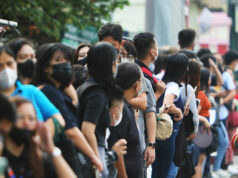LRT-1 operator starts counting cost of virus
THE privately owned company operating the light rail transit’s line 1 has started assessing the impact of the coronavirus outbreak on revenues, its top official said, as rider count further slipped when schools cancelled classes and shoppers avoided malls.
“In January, we had the Taal [eruption] and then the [coronavirus]. We are affected. If there’s no class, then [we are affected]. Taal was almost one week,” Juan F. Alfonso, president and chief executive officer of Light Rail Manila Corp. (LRMC), told reporters last week.
LRMC is the operator of Light Rail Transit Line 1 (LRT-1), which passes by schools and universities along Taft Ave. Some of the line’s stations are near shopping malls, residential condominiums and public markets.
Mr. Alfonso said the coronavirus disease 2019 (COVID-19) had scared commuters, adding to the effects of the Taal Volcano eruption on LRT-1’s ridership.
He noted that the volume of people going to shopping malls had gone down, which consequently affected the train’s ridership.
“Definitely, everybody is affected. We are still studying the full impact. We are not sure what the exact numbers will be,” Mr. Alfonso said. “I think there’s uncertainty because people are not sure of how it is going to affect them.”
For its part, the Department of Public Works and Highways (DPWH) said the coronavirus might have a “minimal impact” on ongoing construction works.
DPWH Secretary Mark A. Villar said: “The [construction] of bridges are still ongoing. So far, wala pa akong nakikitang major effects, tuloy-tuloy naman yung trabaho nila (I don’t see major effects, their work continues).”
“Timelines are the same. If ever may [there are] effects, [they are] minimal. Wala pa akong nakikitang (I don’t see) major effects,” he added.
The Philippines has three confirmed cases of COVID-19, including one death, all involving Chinese nationals. More than 400 people have been checked for infection, more than half of whom had been confined, according to health authorities.
Based on preliminary estimates by the National Economic and Development Authority, the spread of COVID-19 could hurt the country’s economic growth by 0.3% if the outbreak stays longer or until June largely due to its impact on the tourism industry.
Tourist arrivals from China stood at 1.71 million from January to November last year, accounting for 22.9% of the overall tourism visitors to the country during the period, data from the Philippine Statistics Authority show.
The Trade department said the impact on the economy would be “minimal” since the country’s trading activities with China’s Hubei province, where the first case of the virus was detected and is currently on total lockdown, account for just about one percent of the Philippines’ total trade with China. — Arjay L. Balinbin



